|
|
| |
|
INTRODUCTION
DRAWINGS
FLOOR PLAN MODEL
CONSTRUCION 2015 EXTERIOR
2015 INTERIOR
RELATED ITEMS
BIBLIOGRAPHY |
| |
|
|
| |
|
|
During a road trip in June of 2015, to
acquire
Nakoma Golf
Resort furniture, with my son and granddaughter, we had
the opportunity to visit the Pilgrim Congregational Church,
the last church building designed by
Frank Lloyd Wright. The members were very
accommodating and generously allowed us access to the
interior and grounds.
In March, 1958, when the church contacted Wright,
they were specific in "What our Building Must Express.
Preamble: If it is true that architecture reflects the
people that produce it, their life, faith, hopes and fears,
the following comments will be helpful for the architect's
preparation. Two significant items were: A) We believe that
creative architecture will make people aware of the
resources or our Christian faith. B) Man, if we correctly
evaluate his predicament, fells incomplete, fragmentary, and
anxious. Our church ought then to enhance his desire for
wholeness, and develop his capacity to fulfill his divine
destiny and confer his nature as a potential child of God.
Mr. Wright responded, 'Tell the people of the little church
that I will help them out.' After the Presentation drawings
were presented, Mr. Wright said, 'Now your faith has emotion
in it, and so does your building.' " Pilgrim
Congregational Church.
"The legacy of Frank Lloyd Wright continues with the
approaching construction of the Pilgrim Congregational
Church in Redding, designed by the late architect in 1958.
Situated on the crown of a small hill amidst boulders and
pine trees, the church, of course, will use natural
materials to integrate with the natural beauty of the area.
The steeply-pitched roof of the sanctuary will use as its
motif the forms of the surrounding conifers. Long
precast-concrete poles will rise from a stone base to meet
above the sanctuary, supporting a plank roof hung from the
apex. Opaque walls will utilize local boulders to tie in
even more with the terrain. A great triangular expanse of
stained glass will terminate the sanctuary at the crest of
the hill..."
Progressive Architecture, November 1958.
After Mr. Wright accepted the commission, John Rattenbury,
Anthony Puttman and Aaron Green visited the property. "Rev.
Wells, the churches first minister, and church member
Clayton Kantz traveled to Taliesin West at Mr. Wright‘s
invitation, where he walked them though his design studios,
introducing a number of his students, stopping before three
different designs... He turned |
|
to Redding church presentation drawing and said, 'Now, your
faith has emotion in it, and so does your building.' With
tongue-in-cheek, Mr. Wright referred to the Redding design
as 'pole and boulder gothic.' He stated that the design
represented the form of a tent, the ancient dwelling of
Israel, as a symbol of our temporary, migratory and
transient lives." The Building, PCC History.
Due to the lack of funds, instead of hiring a
contractor, the work was accomplished by church members.
"The parishioners, including women and children, along with
volunteers from the community, picked up hammers and
paintbrushes, even borrowed heavy machinery from the nearby
Whiskeytown Dam project, and built much of Frank Lloyd
Wright’s design themselves." Taliesin apprentice Anthony
Puttnam oversaw the construction. Puttnam lived on the site
in a small travel trailer until it got too cold, and one of
the families from the congregation took him in.
The walls contain 91 tons of rock
gathered by church members, sometimes loaded in the back of
family stationwagons.*
Nearly sixty
years after Wright designed the building, the main and most
spectacular portion of the church's design remains unbuilt.
The church was comprised of three sections. The center
Sanctuary, the Chapel wing, and the Fellowship Hall and
administration wing. Only the Fellowship Hall was completed.
"Frank Lloyd Wright cautioned his clients, when they wanted
to build one section of a building
and then complete it at a future date,
they should build the main, or most important, part first.
'Get over the major hurdle first, and then you will always
find the means to get over the minor ones," he told them."
Bruce Brooks Pfeiffer,
Frank
Lloyd Wright Monograph 1951-1959.
The design of the building is based on
an equilateral triangle, the triangle being symbolic of the
spiritual Trinity. Like Taliesin West's Drafting Room, the
exposed exterior supporting beams are an integral part of
the buildings design. Here, the roof is suspended below the
beams, a unique feature of Wright's design, and the only
completed building to utilize this feature. The poles are
precast concrete. The east poles begin inside the fellowship
hall, continue up and out through the roof.
The
poles on the west side of the Fellowship Hall begin outside
the building, cut inside the Fellowship Hall and continue
through the roof. Triangles are integrated throughout the
whole church's design, and can be seen everywhere you look. |
| |
|
*The Wright Time," Sue
Lang, 2014. |
| |
|
|
| |
|
|
| |
|
|
|
|
Pilgrim Congregational Church Drawings |
| |
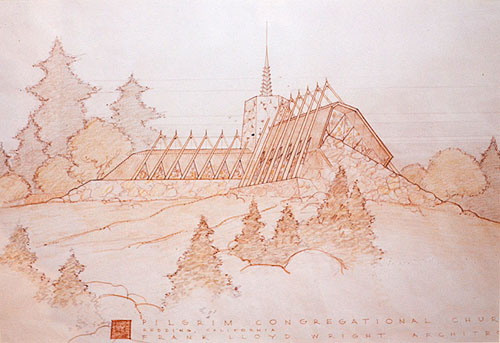 |
|
Perspective of the Pilgrim Congregational Church.
The Chapel is on the left, the main
Sanctuary is in the foreground. "Pilgrim Congregational
Church. Redding, California. Frank Lloyd Wright
Architect."
Courtesy of the Frank Lloyd
Wright Foundation. |
| |
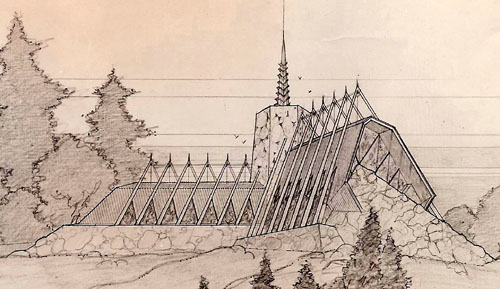 |
| Detail
from original drawing. Courtesy of the Frank Lloyd
Wright Foundation. |
| |
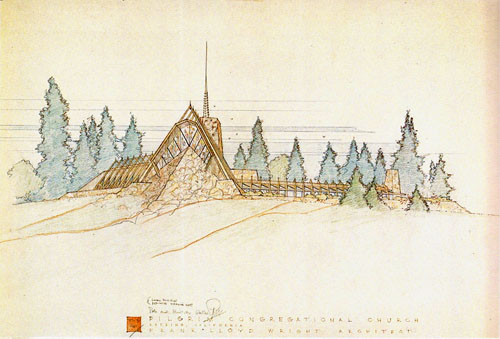 |
|
Perspective of the Pilgrim Congregational Church.
The Chapel is on the left, the main
Sanctuary is in the foreground, the Fellowship Hall
is on the right. "Pilgrim Congregational
Church. Redding, California. Frank Lloyd Wright
Architect." Hand written: "'Pole
and Boulder Gothic." Courtesy of the Frank Lloyd
Wright Foundation. |
| |
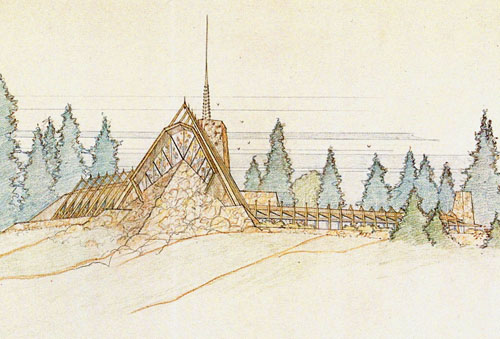 |
| Detail
from original drawing. Courtesy of the Frank Lloyd
Wright Foundation. |
| |
| |
| |
|
|
| |
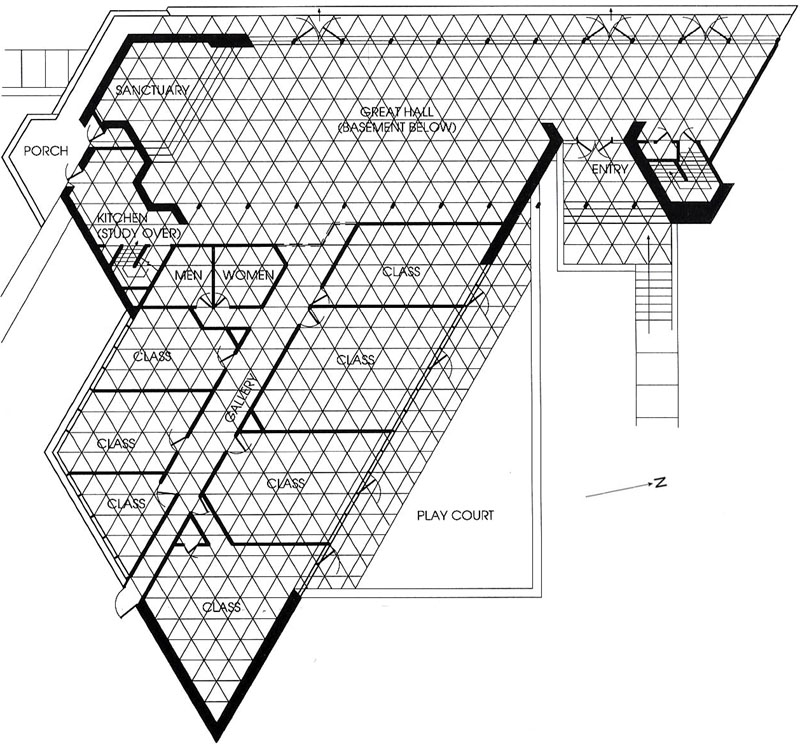 |
|
Frank Lloyd Wright utilized an
equilateral triangle module, each side
of the triangle equaled four feet. Floor Plan
courtesy of William Storrer. |
|
| |
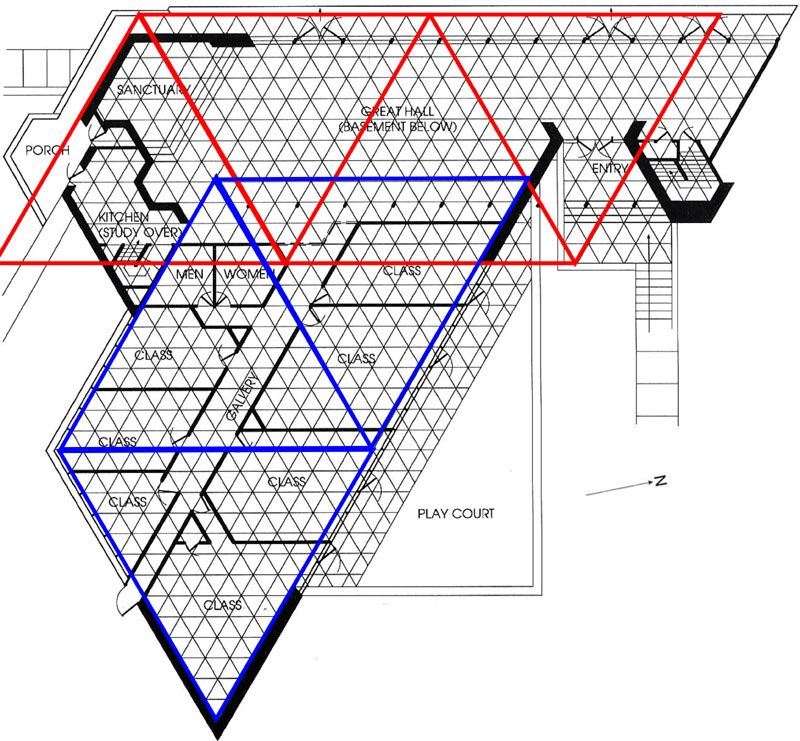 |
|
Pilgrim Congregational Church
floor plan overlaid with equilateral triangles. |
|
|
|
|
|
|
|
|
Pilgrim Congregational Church Model |
|
|
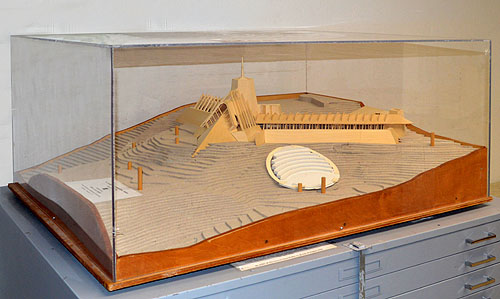 |
|
1)
In the lower level of the Pilgrim Congregational
Church Fellowship Hall is a model of the Church as
Frank Lloyd Wright originally designed it. "Designed
in 1958 By Frank Lloyd Wright. Model by The Frank
Lloyd Wright School of Architecture. August, 2001."
The Chapel is on the left, the main
Sanctuary is in the foreground, the Fellowship Hall
is on the right. The white oval is an amphitheater.
The Fellowship Hall wing on the right has been
completed. Viewed (as if completed) from
the West. Photographed on June
19, 2015 by Douglas M. Steiner. |
|
|
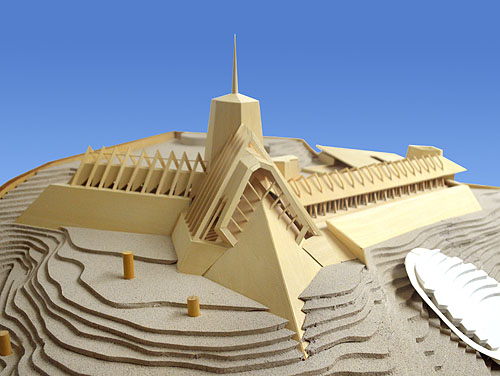 |
|
2)
Pilgrim Congregational Church Model.
Triangles are integrated throughout the
whole church's design, and can be seen everywhere
you look. The Chapel is on the left, the main
Sanctuary is in the foreground, the Fellowship Hall
is on the right. The Fellowship Hall on the right
has been completed. Viewed (as if
completed) from the Northwest. Background modified by Douglas M. Steiner. |
|
|
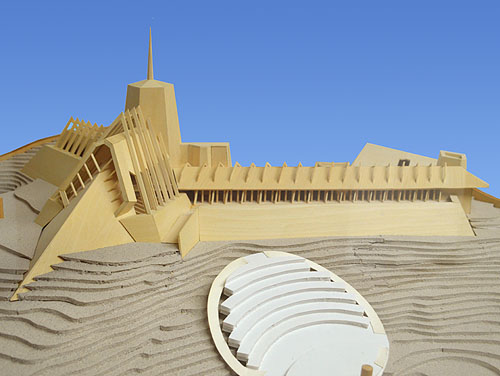 |
|
3)
Pilgrim Congregational Church Model.
Like Taliesin West's Drafting Room, the
exposed exterior supporting beams are an integral
part of the buildings design. The Chapel is
in the background on the left, the main
Sanctuary is in the foreground, the Fellowship Hall
is on the right. Viewed (as if
completed) from the West. Background modified by Douglas M. Steiner. |
|
|
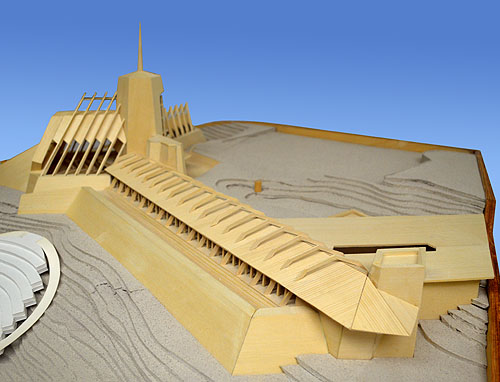 |
|
4)
Pilgrim Congregational Church Model.
The
poles on the west side of the Fellowship Hall begin outside
the building, cut inside the fellowship hall and
continue through the roof. The main Sanctuary is on
the left, the Chapel is in the background, and
the Fellowship Hall is in the foreground. Class
rooms are on the right. Viewed
(as if completed) from the Southwest. Background modified by Douglas M. Steiner. |
|
|
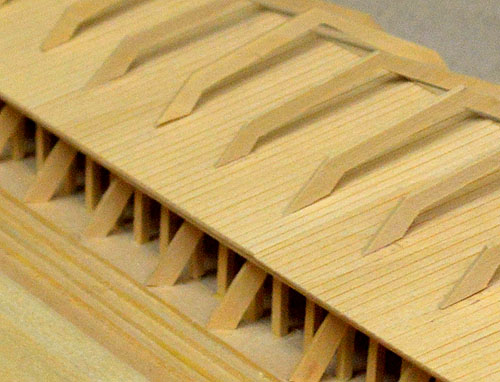 |
|
4A)
Detail of the Fellowship Hall.
The
poles on the west side of the Fellowship Hall begin outside
the building, cut inside the fellowship hall and
continue through the roof. |
|
|
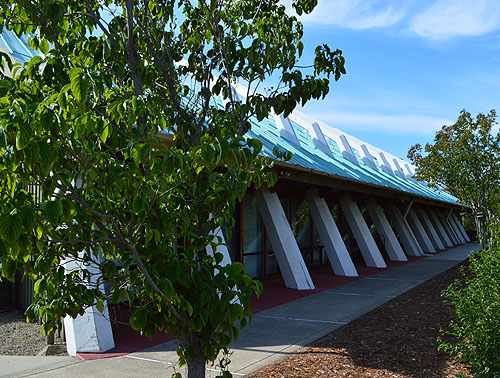 |
|
4B Exterior #31)
The
precast concrete poles on the west side of the
Fellowship Hall begin outside the building, cut
inside the fellowship hall and continue through the
roof. |
|
|
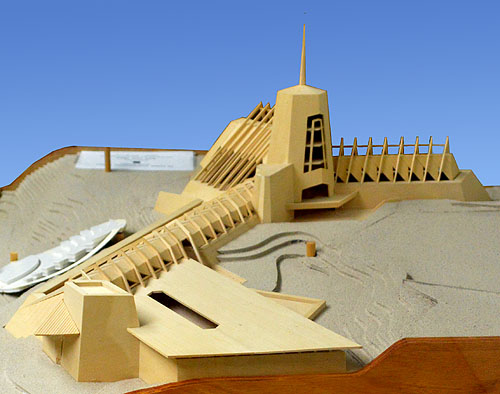 |
|
5)
Pilgrim Congregational Church Model.
The design of the building is based on an equilateral triangle,
the triangle being the symbol of the spiritual Trinity. The
Fellowship Hall and class rooms are in the
foreground. The main Sanctuary is in the
center, the Chapel is on the right.
Viewed (as if completed) from the Southeast. Background modified by Douglas M. Steiner. |
|
|
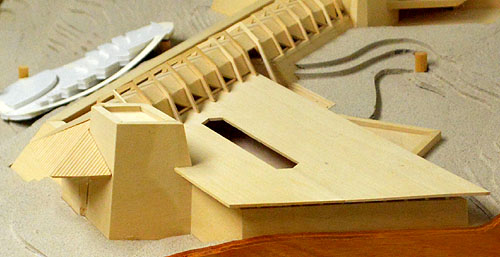 |
|
5A)
Detail of the completed section
of the complex, the
Fellowship Hall and class rooms. |
|
|
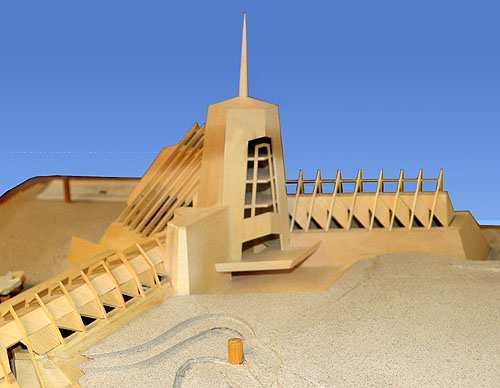 |
|
6)
Pilgrim Congregational Church Model. Frank Lloyd
Wright designed the main entrance as the focal point
of the complex. The roof is
suspended below the beams, a unique feature of his
Wright design, and the only completed building to
utilize this feature. Viewed (as if completed) from the Southeast. Background modified by Douglas M. Steiner. |
|
|
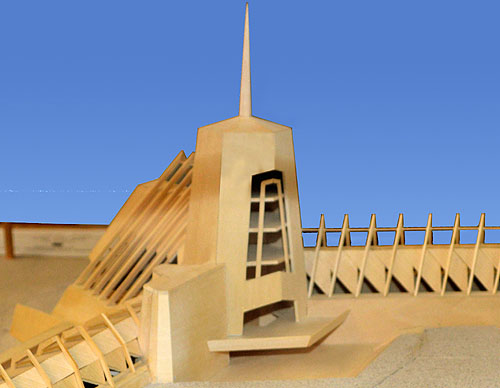 |
|
6A)
Detail of the main entrance Pilgrim Congregational
Church. |
|
|
Photographs by Douglas M. Steiner, copyright 2016. |
|
|
|
|
|
|
|
Pilgrim Congregational Church Construction |
| |
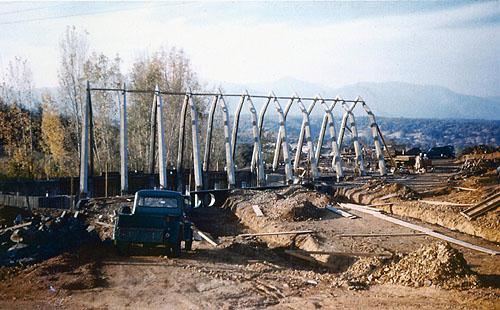 |
| 1) Pilgrim
Congregational Church under construction, viewed from the
Southeast.
Concrete beams have been installed.
Courtesy of Pilgrim Congregational Church. |
| |
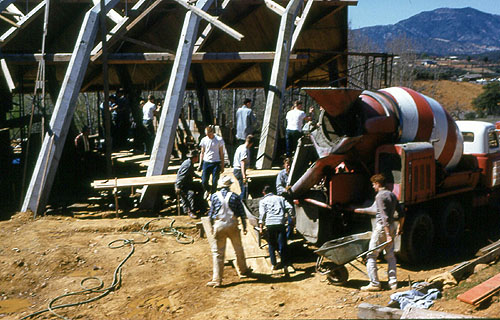 |
| 2) Pilgrim
Congregational Church under construction, viewed from the
Southeast.
Work has begun on the roof. Courtesy of
Pilgrim Congregational Church. |
| |
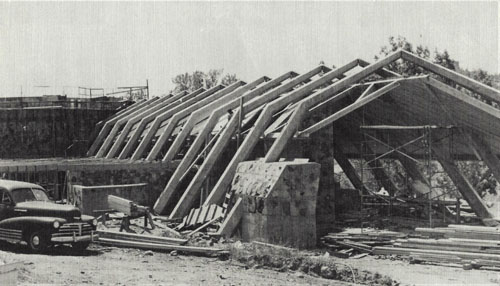 |
| 3) Pilgrim
Congregational Church under construction, viewed from the
Northeast.
Work continues on the concrete rubble walls.
Courtesy of Pilgrim Congregational Church. |
| |
| |
|
|
|
|
Pilgrim Congregational Church Model |
|
|
|
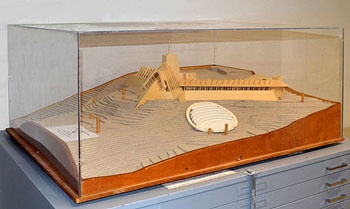 |
Date: 2015
Title:
Pilgrim Congregational Church Model (1958 - S.431)
photographed on June 19, 2015.
Description:
Set of 6 photographs of the Pilgrim
Congregational Church model, June, 2015. In the lower level of
the Pilgrim Congregational Church Fellowship Hall is a model of
the Church as Frank Lloyd Wright originally designed it.
"Designed in 1958 By Frank Lloyd Wright. Model by The Frank
Lloyd Wright School of Architecture. August, 2001." Triangles
are integrated throughout the whole church's design, and can be
seen everywhere you look. Like Taliesin West's Drafting Room...
Continue...
Size:
20 x 14 high res digital color photographs.
ST#:
2015.17.0615 (1-6) |
|
|
|
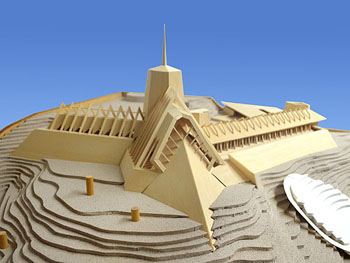 |
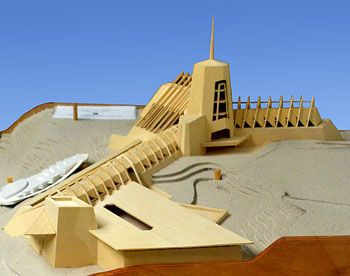
(See additional photographs.) |
|
|
|
|
|
|
|
|
|
Pilgrim Congregational Church Exterior - By Douglas M. Steiner
(2015) |
|
|
|
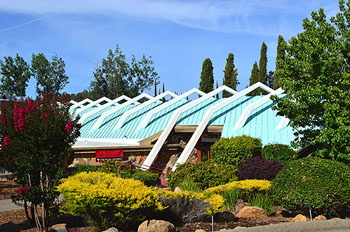 |
Date:
2015
Title:
Pilgrim Congregational Church Exterior (1958 - S.431)
photographed on June 19, 2015.
Description:
Set of 68 images of the exterior of the Pilgrim Congregational
Church photographed on June 19, 2015. The Fellowship Hall is set on a
hillside, so as you approach the church from the parking
lot, the church is below you. The roof is suspended below
the beams, a unique feature of this Wright design, and the
only completed building to utilize this feature. The precast
concrete poles at the entry are on the exterior of the building,
those to the South begin on the interior of the fellowship Hall
and continue up and out through the roof. The rubble masonry
walls are constructed of natural stone set in concrete... Continue...
Size:
20 x 14 high res digital color photographs.
ST#:
2015.15.0615 (1-68) |
|
|
|
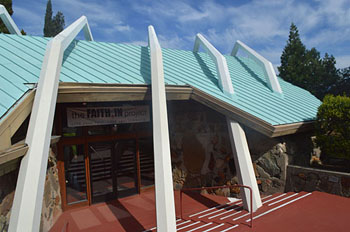 |
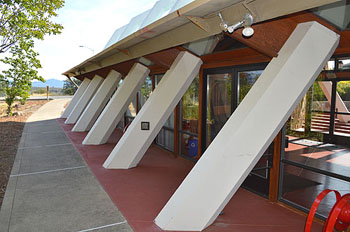
(See additional photographs.) |
|
|
|
|
|
|
|
|
|
|
|
|
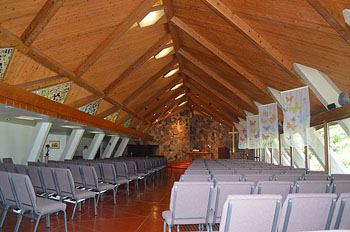 |
Date:
2015
Title:
Pilgrim Congregational Church Interior (1958 - S.431)
photographed on June 19, 2015.
Description:
Set of 23 images of the exterior of the Pilgrim Congregational
Church photographed on June 19, 2015.
The
Concrete beams on the East side of the Fellowship Hall begin
on the interior of the building. Concrete beams on the West
side begin outside, cut through the wall, then
continue though the roof. The floor is tinted Cherokee red.
Low stairs lead up to the Sanctuary. A fireplace is set into
the two-story rubble stone mass. The hexagon ceiling lights
are created with six equilateral triangles then set within
triangles.
Clerestory stained glass windows, created with "Slag" or
chunks of glass, are...
Continue...
Size:
20 x 14 high res digital color photographs.
ST#:
2015.16.0615 (1-23) |
|
|
|
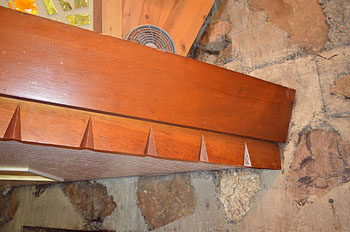 |
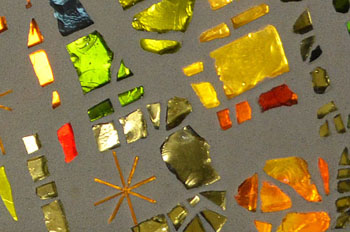
(See additional photographs.) |
|
|
|
|
|
|
|
|
|
|
|
|
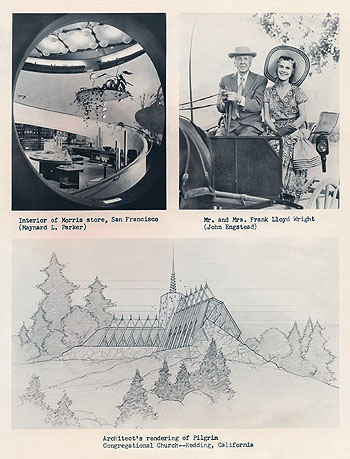 |
Date:
1962
Title: Wright at 88. 1955.
Press photograph for "Architecture:
Man in Possession of His Earth".
Description:
Includes three images. 1) V. C. Morris Gift Shop (S.310 - 1948).
Caption on face below image; "Interior of Morris store, San
Francisco (Maynard L. Parker)." Originally photographed in 1948.
2) Mr. And Mrs.
Frank Lloyd Wright
in a horse draw carriage, 1955. Caption on face below image;
"Mr. And Mrs.
Frank Lloyd Wright
(John Engstead). Photographed by John Engstead, it appears that
Wright is wearing the same suit, tie and handkerchief as he did
when he was
photographed
on June 8, 1955 for his 88th birthday. She has changed her
outfit. On June 8th, Engstead photographed images for the
November 1955 issue of
House Beautiful,
published on page 243, bottom left. 3) Rendering of the
Pilgrim Congregational Church (Project 1958). Caption on face
below image; "Architect’s rendering of Pilgrim Congregational
Church – Redding, California." Caption pasted on verso; "Memoir
from a Master Builder.
Frank Lloyd Wright’s
last book, "Architecture: Man in Possession of His Earth,"
explains architecture in terms of building materials (Doubleday,
$5.95). Prefaced by a biography of the late architect by his
daughter, Iovanna Lloyd Wright, the volume is illustrated
throughout with sketches, renderings, and photographs. Picture
Release Date: November 2, 1962. Book Release Date: November 9,
1962. From: Louise Thomas. Doubleday & Co., 575 Madison Ave.,
N.Y. 22, N.Y. MU8-5300.)
Size: Original 8 x 10 B&W
photograph.
1496.03.1210 |
|
|
|
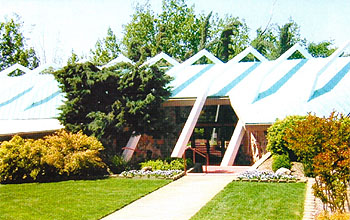 |
Date: 1990
Title:
Pilgrim Congregational Church
Description:
"Pilgrim Congregational Church, 2850 Foothill Boulevard, P.O.
993183, Redding, CA 96099-3183, (530) 243-1233. Provided by Olan
Mills Directory Division." Circa 1990. (S.431 -
1958)
Size:
5.5 x 3.5
ST#: 1990.74.0809 |
|
|
|
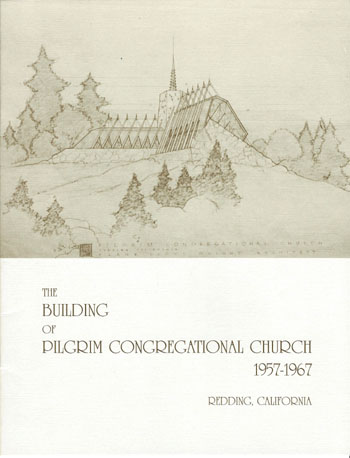 |
Date:
1992
Title:
The Building
of Pilgrim Congregational Church, 1957-1967, Redding California
(Soft Cover) (Published by Pilgrim Congregational Church,
Redding, California)
Author:
Ashbaugh, Barbara L.
Description:
"...Committee members traveled to the city to meet Mr. Wright
when his renderings for the Marin Civic Center were made public.
As Ray Wells recalls, Meeting Frank Lloyd Wright was quite a
thrill. He was exceedingly deferential to this young minister. I
was about as naive as he was arrogant, but he reaches across and
tapped my knee as we sat in a tight circle in Aaron's office and
said, ‘Well Domini,' A familiar Scottish term for a reverend -
‘how long do you suppose we'll keep building churches?'
Obviously, a spirited conversation followed, and we had to work
at getting back to the reason for which we came..."
Size:
8.5 x 11
Pages: Pp 14
ST#:
1992.107.0615 |
|
|
|
|
|
|
|
|
|
|
|
| |
|
"Progressive Architecture," November, 1958,
p.70. |
|
"Architecture: Man
in Possession of His Earth," Wright, 1962, p.126-127. |
|
"The Drawings
of Frank Lloyd Wright," Drexler, 1962, Plate 239. |
|
"Frank Lloyd
Wright Monograph 1951-1959," Vol. 8, Text: Pfeiffer;
Edited and Photographed: Futagawa, 1990, p.356-359. |
|
"The
Frank Lloyd Wright Companion," Storrer,
1993, p.463. |
|
"Details
of Frank Lloyd Wright, The California Work 1909-1974,"
Dunham, 1994, p.136-139. |
|
"The
California Architecture of Frank Lloyd Wright,"
Gebhard, 1997, p.116-119. |
|
"Frank Lloyd
Wright - Field Guide," Heinz, 2005, p.22. |
|
"Frank Lloyd
Wright. The Buildings," Hess, 2008, p.282-287. |
|
|
|
|
|
|
|
|

CLICK TO ORDER






























